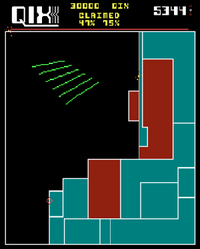Qix
| Qix | |
|---|---|
 Arcade flyer | |
| Developer(s) |
|
| Publisher(s) | |
| Designer(s) | Randy Pfeiffer and Sandy Pfeiffer |
| Platform(s) |
|
| Release date(s) | |
| Genre(s) | Action |
| Mode(s) | Up to 2 players, alternating turns |
| Cabinet | Standard and cocktail |
| Arcade system | Qix Hardware [1] |
| Display | Vertical orientation, Raster, standard resolution: 256x240 |
Qix (pronounced "kicks") is an arcade game released by Taito America Corporation in 1981.
Gameplay

The objective of Qix is to fence off, or “claim”, a supermajority of the playfield. At the start of each level, the playing field is a large, empty rectangle, containing the Qix — a sticklike entity that performs graceful but unpredictable motions within the confines of the rectangle.
The player controls a Stix that can move around the edges of the rectangle. Holding down one of the draw buttons allows the marker to move into unclaimed territory in an attempt to create a closed shape. If completed, the captured area (defined as the side opposite of where the Qix is) becomes filled in with a solid color and points are awarded. To complete a level, the player must claim 75% of the playfield (adjustable by the arcade operator to be between 50% and 90%).
The player's marker can move at two different speeds; areas drawn exclusively at the slower speed (orange-red on the screenshot shown) are worth double points. It cannot cross or backtrack along a line in progress.
A life is lost if the Qix touches a line as it is being drawn or if the marker is touched by any of the Sparx – enemies that traverse all playfield edges except uncompleted lines. In addition, if the marker stops while drawing a line, a fuse will appear and burn along the uncompleted line toward the marker; if it reaches the marker, the player loses one life. The fuse disappears once the player moves the marker again. The player has no defenses against the enemies and must out-maneuver them in order to survive.
A meter at the top of the screen counts down to the release of additional Sparx, and the mutation of all Sparx into Super Sparx which can chase the player up an uncompleted line.
After the player completes two levels, the difficulty increases by the inclusion of multiple Qixes, additional Sparx, speed increases, and the eventual appearance of only Super Sparx. In levels with multiple Qixes, the player can also complete the level by splitting the playfield into two regions, each containing at least one Qix.
Ports and re-releases
Taito produced their own ports or licensed Qix for porting to various platforms over its lifetime. This includes ports for the Atari 5200 (1982), Atari 400/800, Apple II (1989), Commodore 64 (1989), DOS (1989), Amiga (1989) (graphically enhanced), Apple IIGS (1990), Game Boy (1990) (available on 3DS Virtual Console), NES (1991), and Atari Lynx (1991).
Qix spawned a minor revision called Qix II-Tournament in 1982, which was followed by Super Qix in 1987. Another sequel, Twin Qix, reached prototype stage in 1995, but was never commercially released. The later game Volfied, also known as Ultimate Qix on Sega Genesis/Mega Drive or Qix Neo on PlayStation, was created as an additional sequel to Qix and also released on several mobile phones.
The Game Boy version of Qix was developed by Nintendo and features at least two intermissions in which Mario is involved: in one, he is in the middle of a desert wearing Mexican clothing and playing a guitar with a vulture looking on; in another one, he's with Luigi and Princess Peach.[2]
In 2000, a port for the Game Boy Color was released called Qix Adventure. This version features a new "Adventure" mode where the player travels a map screen, taking on various opponents which appear on the playing field. Although optional, enclosing this opponent in the box will open a treasure chest, which can also be enclosed, giving the player an item.
The original arcade version of Qix has been re-released in various Taito game collections which include Taito Legends 2 (PS2, Xbox, Windows) and Taito Legends Power-Up (PSP). It’s also available via the online game-playing services Gametap and Arcade Boss.
On December 9, 2009, Taito released for the Xbox Live Arcade an improved version of Qix: Qix++.
Reception
Electronic Games in 1983 reported that the arcade version of Qix "grabbed the gaming world with its color and imaginative design. Almost immediately it rose to the top of the charts." Its popularity quickly declined, however; Taito's Keith Egging stated "Qix was conceptually too mystifying for gamers ... It was impossible to master and once the novelty wore off, the game faded."[3] Computer Gaming World in 1989 called the computer version of Qix "a fascinating game. It is highly recommended to those who are at one with the universe ... I do love and hate it so".[4]
Legacy
Clones of Qix include the 1983 MS-DOS based clone Styx, the Gals Panic series of games, and Art Class, a mini-game in the 2006 PS2 game Bully.[5]
Qix appears in the film Wreck-It Ralph. It is seen in Fix-It Felix Jr.'s 30th Anniversary party.
References
- ↑ http://www.system16.com/hardware.php?id=633
- ↑ Qix Good Ending - YouTube
- ↑ Pearl, Rick (June 1983). "Closet Classics". Electronic Games. p. 82. Retrieved 6 January 2015.
- ↑ Sipe, Russell (November 1989). "What Do You Do For Qix". Computer Gaming World. p. 39.
- ↑ Bully Review - PlayStation 2 Games - CNET Reviews
External
- Qix guide at StrategyWiki
- Arcade-history entry for Qix
- Qix at MobyGames
- Qix at the Killer List of Videogames
- Taito Legends Pocket (aka Power-Up) at IGN
- Qix at The Hall of Light (HOL)
- Xiq, a Qix inspired game at lcdevs.com
| ||||||